Physical Address
304 North Cardinal St.
Dorchester Center, MA 02124
The physical rehabilitation of patients who have sustained a burn injury is a serious undertaking and requires, among other disciplines, the involvement of physical therapy, occupational therapy, and exercise physiology in order to produce the best functional and cosmetic outcomes. Recent advances in medicine have significantly contributed to increased patient survival rates, and this necessitates faster, more comprehensive, and prolonged burn rehabilitation. With severe burn injuries, as perhaps with any other order of trauma, there is an urgent need for immediate and aggressive initiation of patient-specific rehabilitation programs. The distribution and depth of the burn injury clearly predict the patterns of deformity and joint contractures and mandate the establishment of therapeutic goals and the initiation of treatment as soon as possible. As stated previously, the more extensive the burn injury, the greater the rehabilitation challenge becomes. A seriously burned extremity in an otherwise modestly burned patient is much easier to restore to function than an extremity similarly burned in a patient with full-thickness burns involving multiple anatomical surfaces. In the case of seriously burned patients, the immediate and primary focus will always be preservation of life and wound coverage. Today, burn rehabilitation specialists intervene early on in the patient recovery process through the development and implementation of rehabilitation programs intended to maximize the potential of functional and cosmetic patient recovery.
The primary short-term rehabilitation goal is to preserve the patient's range of motion (ROM) and functional ability. Long-term rehabilitation goals include returning patients to independent living and teaching patients to compensate for any permanent functional loss suffered as a result of the burn injury while contributing toward acceptable cosmetic outcomes.
This chapter addresses the evaluation, positioning, splinting/orthotics, serial casting, prosthetics, scar management, exercise, performance of activities of daily living (ADL), and patient and caregiver education utilized in burn rehabilitation along the continuum of care.
Upon admission to the burn center, patients undergo a comprehensive evaluation by burn rehabilitation therapists (physical and/or occupational therapists) in order to assess their medical status and formulate a plan of care. It is crucial that therapists document the findings of their evaluation in the patient's medical record because these findings will serve as the baseline upon which progress will be determined. A good burn evaluation should include (1) the history of how the accident occurred; (2) an interview with the patient's caregiver to gather information regarding the patient's preinjury functional status and activity level; (3) documentation of the etiology, classification, and total body surface area (TBSA) of the burn injury; (4) documentation of associated injuries such as fractures, smoke inhalation injury, and exposed tendons and bone; (5) measurement of edema, ROM, strength, and sensation if appropriate; (6) assessment of ADL performance; (7) need for positioning of affected areas, including splinting; (8) development of short- and long-term treatment goals; and (9) development and documentation of a treatment plan. The patient's status should be reassessed on a regular basis and after each surgical procedure to update the plan of care as needed. Therapists should communicate the results of their evaluation and the treatment plan to the burn team and to the patients and their families.
In a study of burn survivor perceptions about rehabilitation, positioning and splinting routines were viewed positively and identified as useful in order to improve movement. Positioning of the burned patient is fundamental to bringing about the best functional outcomes in burn rehabilitation. Positioning programs should begin immediately upon admission to the burn center and continue throughout the rehabilitative process. The role of the burn rehabilitation therapist is invaluable in designing a patient-centered positioning program, one that reduces edema, enables wound care, facilitates joint alignment, minimizes the risk of peripheral neuropathy, and counteracts all contractile forces without compromising function. In planning and implementing an effective patient-specific positioning program, the therapist should be aware of the patient's TBSA of burns, the depth of all injuries, respiratory status, and associated injuries such as exposed tendons/joints or fractures. Individualized positioning programs are monitored closely for any necessary adjustments depending on the patient's medical status. The quote that “the position of comfort is the position of deformity” applies to every burned patient who has sustained a serious injury. The risk of deformity after burn injury is real, and burn scar contractures should be anticipated and dealt with proactively.
Anti-deformity positioning can be achieved through multiple means: splinting, mechanical traction, cut-out foam troughs and mattresses, pillows, strapping mechanisms, serial casting, and, in some cases, through surgical application of pins. The burn therapist needs to be aware of physician-specific protocols and work closely with the entire burn team to design the most effective positioning program. Orthotics and splinting devices are vital in burn rehabilitation because they are utilized extensively to obtain appropriate positioning of the entire body and to counteract the contractile forces of scarring that lead to deformity. The application of positioning strategies is used to influence soft-tissue lengths to limit the loss of ROM due to scar formation and contraction. No matter how the burn therapist approaches splinting (material choice, design, and application schedules), the goal is to achieve the best functional outcome at the completion of rehabilitation. When fabricating a splint or an orthosis, the burn therapist must be aware of the anatomy and kinesiology of the body surface to be splinted. Also, the therapist should be well aware of all mechanical principles of splinting as they relate to pressure, mechanical advantage, torque, rotational forces, first-class levers, friction, reciprocal parallel forces, and material strength.
The general outcomes for the use of splints in a burn rehabilitation setting have been identified as protection of vulnerable structures, preservation of ROM, suppression of scar, and correction of soft-tissue contractures. The goals for positioning and splinting will vary with the phase of burn rehabilitation. In the acute phase, the goal is edema control and pressure relief; in the intermediate phase, the aim is tissue elongation and graft protection; and, for long-term rehabilitation, the target is tissue elongation. Positioning and splinting must be designed in a way to:
Allow for edema reduction
Maintain joint alignment
Support, protect, and immobilize joints
Maintain and/or increase ROM
Maintain tissue elongation
Remodel joint and tendon adhesions
Promote wound healing
Relieve pressure points
Protect newly operated sites (grafts/flaps)
Stabilize and/or position one or more joints, enabling other joints to function correctly
Assist weak muscles to counteract the effects of gravity and assist in functional activity
Strengthen weak muscles by exercising against springs or rubber bands.
Devices should:
Not cause pain
Be designed with function in mind
Be cosmetically appealing
Be easy to apply and remove
Be lightweight and low-profile
Be constructed out of appropriate materials
Allow for ventilation to prevent skin/wound maceration.
Typical burn care positioning protocols describe the supine position in great detail. More emphasis is now being placed on the use of side-lying and prone positioning for patients with large burns who must be immobilized for extended periods due to newer grafting techniques that cover larger areas with fragile skin substitutes. When designing positioning programs, the joint angles are aligned in neutral postures and the supporting surfaces are modified to maximize the surface area to body contact while protecting bony prominences from compression.
Side-lying may be used on a rotating basis for patients at risk for sacral or scapular skin breakdown. In a preventive program, the rotation is right side to supine to left side. The order is then reversed on a 1- to 2-hour schedule. Full side-lying at 90 degrees from supine should not be allowed for any significant length of time due to excessive pressure over the greater trochanter. A more appropriate position for side-lying is approximately 30–40 degrees from the supine position, which distributes pressure more evenly between the head of the femur and the lateral portion of the sacrum.
The mechanics of a side-lying position can be accomplished using pillows or wedges made of foam or wood. The advantage of foam or wooden wedges is that they can be placed directly under the mattress with less manipulation of the patient. As the rotation schedule is completed, the wedge can either be removed for the supine position or transferred to the opposite side of the mattress to achieve side-lying on the opposite surface.
Prone positioning strategies are usually the position of last resort ( Fig. 47.1 ) and are reserved for patients who are not successfully managed in supine or side-lying. For example, there may be nonhealing grafts or wounds in the rectal region that increase the risk of sepsis due to the introduction of fecal matter. Other candidates for this protocol include those with sacral pressure ulcers or posterior trunk grafts that are not healing.
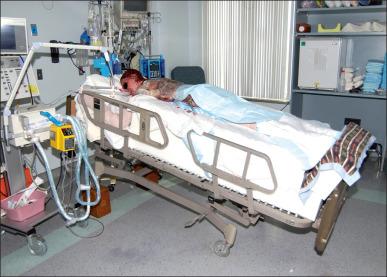
The clinician faces a host of issues that must be considered when instituting a prone positioning program. The airway is always the first issue that must be considered when designing a prone position mattress. The supporting surface is cut from a solid open-cell foam mattress that is placed on a wire mesh bed frame. Airway concerns are addressed first, and the patient is evaluated for mode of respiration. Nasal and tracheal intubation are issues to consider, but these are not contraindications for the prone position. A trough should be provided so that direct access can be obtained for routine airway care and if breaths are needed using an Ambu-bag. If the airway becomes compromised, the prone position should be abandoned immediately until proper respiration is established.
The facial opening should be cut in a manner that maximizes weight distribution without allowing the head to enter into the opening. Using this protocol places direct weight-bearing pressure on the brow ridge, zygomatic arches, and the anterior mandible. These structures should be monitored closely, and the patient should be educated that breakdown is likely to occur due to the limited subcutaneous tissue protecting the face. If burn scars are encroaching on the eyelids, then the corneas should be evaluated as well. Corneal abrasion can be avoided with due diligence and prevention of the foam from contacting the unprotected eye. Countersinking a gel cushion into the upper portion of the foam mattress can protect the forehead and brow ridge.
The sternum, pelvic region, and patellae are protected with the use of an air-cell mattress that is inserted into the mattress in a lengthwise manner. The air-cell segments are typically supplied in standard lengths and may not reach from the sternum to the ankles. If there is an unsupported area between the distal portion of the mattress and the dorsum of the foot, then the area can be supported with open-cell egg-crate-type foam. The feet are supported at the distal end of the mattress with a foam footboard. Extra precautions should be taken to evaluate the elevation of the great toe from the supporting bed frame.
In the prone position, all traditional joint alignment suggestions are maintained with the possible exception of the elbows. Shoulder mobility dictates the style of prone mattress that can be made for the individual burn patient. If the patient has greater than 115 degrees of abduction, then the mattress is modified to horizontally adduct and externally rotate the shoulder while flexing the elbow to allow for elevation of the hands. This minimizes edema in the hands and allows for greater function once the prone position is no longer needed. If the shoulders have limited abduction, then a “butterfly” cut is used to allow for horizontal adduction of the shoulder to protect the brachial plexus, with the hands remaining slightly dependent. This will result in some hand edema, which can be addressed with pressure wrapping (Coban glove) and active exercise.
Acutely, in aiding with facial edema reduction, the head should be positioned by placing it in midline and elevating the head of the bed at 30–45 degrees if the patient's hips are not involved. In cases where the hips are burned, the entire bed may be elevated at the head with the use of shock blocks (wooden blocks, 12–16 inches, with recessed slots for bed legs) or the use of the reverse Trendelenburg position. These methods avoid positioning the hips in the flexed position that promotes contracture formation and deformity if persistent ( Fig. 47.2 ).
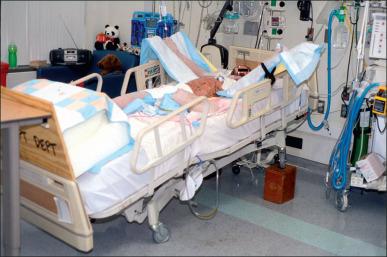
In those cases where the ears are burned, they may be protected by strapping ear cups made of thermoplastic materials or foam. An ear conformer may be constructed to prevent the rim of the ear from contracting toward the head. Internal ear canal splints may also be fabricated and serially adjusted as the circumference of the canal increases. In addition, if the ear is affected, a soft circular foam can be positioned posteriorly to the head to elevate the ears off the surface of the bed. A nasal obturator may be required to maintain the nostrils open. These obturators may be serially adjusted as the circumference of the nostril increases. Mouth splints are utilized for the prevention of oral microstomia. These devices are custom-made by the therapist, or they may be obtained commercially. Mouth splints may be fabricated static or dynamic for horizontal or vertical opening of the mouth. In cases of severe microstomia, where compliance is an issue, an orthodontic commissure appliance that attaches to the teeth may be fabricated by an orthodontist. The use of stacked tongue blades is an acceptable technique to aid in reversing oral microstomia. Ongoing research looks at the development of a microstomia device that circumferentially opens the mouth according to its anatomy ( Fig. 47.3 ). In the post-acute phase, facial scar hypertrophy may require fabricating a high thermoplastic transparent mask, such as the Uvex and W-clear masks, or a silicone elastomer facemask. A semi-rigid low thermoplastic opaque mask may also be fabricated depending on the state of scar maturation.
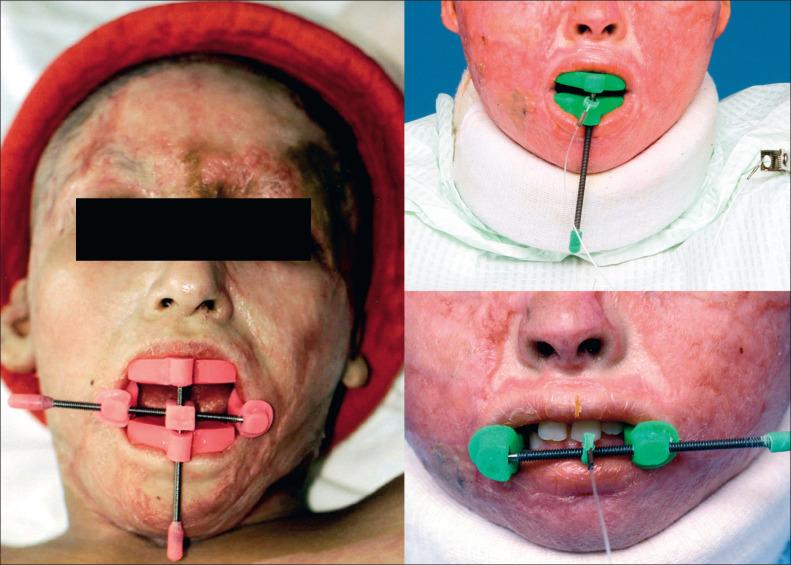
The neck is positioned in neutral or in slight extension of approximately 15 degrees without any rotation. The amount of neck extension must not be so great that traction on the chin causes the mouth to open. Positioning may be achieved with a short mattress supine, a rolled towel, or foam cushion placed behind the upper back on the scapular line. Pillows should be avoided in the cases of anterior neck burns because they may lead to flexion contractures. In the case of anterior neck burns, a conforming custom thermoplastic collar may be fabricated ( Fig. 47.4 ). For burns along the lateral surface of the neck and some long-term needs, a soft neck collar or a Watusi-type collar may also be fabricated as the patient's wounds heal and contractures or scars develop. The Watusi-type collar allows for isolated, direct pressure to a thicker scar band. It has been observed that, in some cases, acute patients rotate or laterally flex their neck on one side, which may lead to a lateral neck contracture (torticollis). If the patient is to remain in bed for a while, a dynamic head strap mechanism may be fabricated to counteract the lateral neck contractile forces and bring the neck into the neutral position. For the prevention of torticollis, the therapist may fabricate a lateral neck splint that conforms to the patient's head, the lateral neck, and anterior/posterior shoulder ( Fig. 47.5 ).
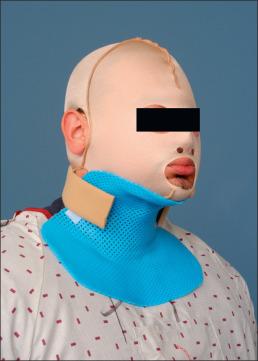
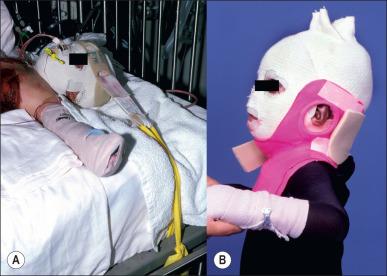
Contracture resulting from unilateral or asymmetric burns of the neck, axilla, trunk, and groin will cause lateral curvature of the spine (scoliosis). The level and amplitude of curvature will vary with the site and severity of the contracture. In addition, pelvic obliquity accompanying asymmetric hip or knee flexion contracture will impose a lateral lumbar curve. As long as the patient is recumbent, lateral curvature can be prevented by maintaining straight alignment of the trunk and neck ( Fig. 47.6 ). However, the curve is often insidious in onset and will not be recognized until the patient begins to walk. Trunk list observed early in the ambulation period can be simply a transient accommodation to pain and wound tightness, but a persistent list may herald the development of scoliosis. Other subtle signs of spinal curvature are asymmetry of shoulder levels, scapular asymmetry, asymmetry of dependent upper extremity alignment to the trunk, and asymmetry of pelvic rim levels. A spinal mobilization exercise program is established with the patient once a curvature is identified; however, once there is an established asymmetric contracture it is difficult by therapeutic means to stretch it out, so it is probably better to deal surgically with a deforming scar early than to permit even minor scoliosis to persist.

Acutely the upper extremity positioning program focuses on reducing edema through elevation. Failure to reduce edema in the first 48–72 hours can promote the development of a fixed deformity. Additionally, improper elevation techniques for the upper extremity may lead to soft-tissue calcification, increased bone density, and compressive neuropathies. The recommended position for the burned shoulder and axillary complex is 90 degrees abduction, 15–20 degrees horizontal adduction, and external rotation toward maximal. Abduction alone places the glenohumeral joint at risk for anterior subluxation, if the position is maintained for an extended period. Placement in horizontal adduction anatomically reduces the potential for tractioning of the brachial plexus or peripheral nerve compression. The glenohumeral joint is externally rotated in order to counteract anticipated deformities of internal rotation and adduction and to maintain balance of the soft tissues of the shoulder complex.
Positioning of the shoulder may be achieved with splints, silicone-filled pillows, bedside tables, foam arm troughs, metal abduction troughs, and thermoplastic slings suspended from a trapeze mechanism ( Fig. 47.7 ). Splinting of the shoulder joint becomes more intensive as scar maturation heightens the risk of contracture development. Airplane splints have been used for the resolution of axillary contractures and postoperatively to protect reconstructive procedures. Upon closer inspection of the literature, a randomized controlled trial of adults with shoulder burn involvement compared splinting to no splinting with regard to functional outcomes and determined that shoulder splints did not improve clinical outcomes in the study population and that low adherence rates suggest splinting may be unacceptable to patients. However, more recently, a pilot study of a newly designed multiaxis shoulder abduction splint concluded that the device resulted in a significant improvement in shoulder abduction angle compared to unsplinted patients. The use of shoulder splints needs to be studied further to determine patient types, design principles, and timing of application.
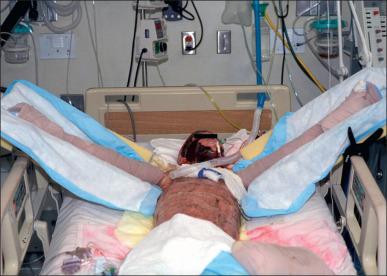
In situations where deemed necessary, shoulder splints can be modified. To accommodate wound dressings and promote healing, a three-piece airplane splint may be fabricated ( Fig. 47.8 ). Foam arm wedges may be substituted when the patient is in the bed postoperatively, when it is difficult to fabricate an airplane splint. Other adaptations may be required in the presence of amputations. Prefabricated airplane splints come equipped with mechanisms that allow for adjustments depending on available shoulder ROM. A figure-of-eight axillary wrap may be utilized in conjunction with an airplane splint to provide compression for axillary contour and elongation of skin surfaces ( Fig. 47.9 ). A descriptive study using the figure-of-eight sling after scar release and skin grafting indicated that the device is safe, comfortable, easy to use, and promotes compliant use by the patient; with at least as reliable results as the use of abduction splints. For successful contracture management to the shoulder, the positioning program must be supplemented by exercise routines for ROM, strength, and endurance.
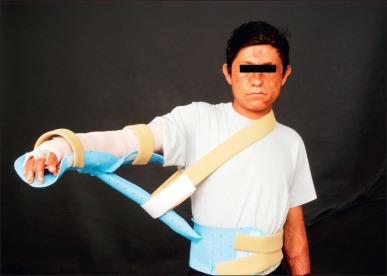
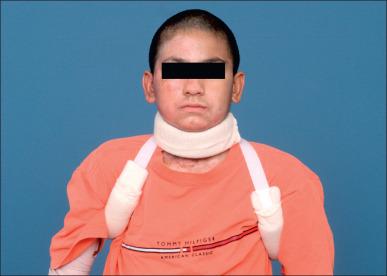
Acutely, elevation and extension is the desired position of the elbow. Severe burns involving the elbow may result in flexion contracture and threaten posterior exposure of the joint. Full extension is the protecting position for the elbow. If the joint is exposed posteriorly, extension may need to be rigidly maintained for several weeks. If the joint is not exposed, mobilization into increasing flexion range can begin very soon after the burn injury. The elbow is integral to the so-called delivery system for the hand, and elbow range to full or near-full flexion is more important for overall function than range to full or near-full extension.
Radial head rotation for pronation and supination is less often affected by the burn injury than is flexion and extension. The pronators and supinators are frequently injured in electrical accidents where bone heats, being a poor conductor, destroying the muscles closest to it. Forearm rotation is essential for accurate hand placement, and the rehabilitative program must address pronation and supination during functional tasks and skills training. Depending on the location and severity of the injury, the forearm may be positioned in neutral to slight supination. Static elbow splints may be soft or custom-fabricated of thermoplastic materials. An anterior elbow conformer may be fabricated over the burn dressing. Dynamic elbow extension or flexion splints may be utilized to provide prolonged, gentle, sustained stretch and aid in the correction of contractures. Forearm dynamic pronation/supination splints may be custom-fabricated or obtained commercially for the correction of contractures.
A comprehensive team approach from initial evaluation through long-term follow-up is essential to maximize the functional outcomes for individuals with hand burns. Treating therapists must have a thorough understanding of the effects of thermal injury on the anatomical structures of the wrist and hand. The presence of dorsal hand edema leads to intrinsic muscle ischemia and a resultant “intrinsic-minus” posture. The unsupported burned hand postures in wrist flexion, metacarpophalangeal (MCP) hyperextension, interphalangeal (IP) flexion, thumb adduction, and thumb IP flexion. The overall appearance is that of a claw deformity ( Fig. 47.10A ). Edema following a full-thickness burn to the dorsal hand imposes the positions of MCP hyperextension and IP flexion ( Fig. 47.10B ). Persistence of this position results in a claw hand deformity. The claw hand posture is primarily due to post-burn edema but may persist throughout the course of treatment due to scar contracture or in the presence of peripheral neuropathy. Among the digits, the second and fifth most easily drift into MCP hyperextension because each has a proper extensor tendon.
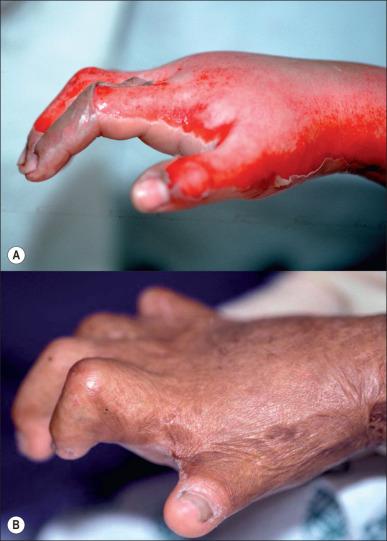
While superficial burns result in minor, transient edema, full-thickness injuries exhibit more severe and prolonged post-burn edema. Superficial hand burns should not be splinted in order to allow for frequent movement and the freedom to function independently. In cases of severe thermal injury, it is important to monitor for signs and symptoms of vascular insufficiency or compartment syndrome. In treating the edematous burned hand, it is important to position the hand above the level of the heart at all times if it can be accomplished without compromising the neurovascular supply to the hand.
Acute positioning of the wrist and hand after burn injury is for edema control; immobilization/protection of tendons, joint structures, and/or skin grafts; and optimal positioning to maintain soft-tissue lengths and functional abilities. Within the first 24–72 hours, it is recommended that the wrist be splinted into extension, allowing the MCP joints of digits one through five to fall into flexion due to the normal tenodesis action of the wrist and hand. Wrist extension is essential to control digital position and prevent a claw hand deformity. The recommended functional position of the wrist is from 0–30 degrees of extension.
The burned wrist and hand should be positioned to oppose impending wound contracture. A review of the burn literature indicates some disagreement regarding positioning of the wrist and hand. A consensus panel of burn rehabilitation experts discussed splinting of the MCP joints in at least 70 degrees of flexion at night. Another group of burn experts went a little further and described the position of choice as being wrist extension, MCP flexion greater than 60 degrees, and IP joint extension. A third group, including surgeons, described the desired position as 20–30 degrees of wrist extension, approximately 80 degrees of MCP flexion, IP extension, and thumb in maximum abduction. The authors of this text previously recommended that the optimal position for the burned hand is wrist 0–30 degrees extension, 70–80 degrees MCP flexion and IP joints in full extension (although some burn centers may advocate a slight amount of IP flexion, deeming the position to be “safe”). The thumb should be positioned in a combination of palmar and radial abduction, with the MCP/IP joints slightly flexed. An example of a modification to the burn hand splint that would improve the protection of grafted areas through the use of a “roll bar” is described in the literature. What is clear is the need for controlled studies to determine the appropriate body positions to reduce deformity risks and to determine the most effective methods for the use of splinting for maintaining ROM or contracture management. All the described positions resemble the “intrinsic-plus” position and can be achieved through fabrication/fitting of a burn hand splint by a rehabilitation therapist ( Fig. 47.11 ). The burn hand splint positions the hand appropriately to minimize soft-tissue contractures and preserve functional mobility. Involvement of the extensor tendon apparatus should be assumed and protected until viability of the system is known. Continuous splinting is recommended to manage edema, exposed tendons, peripheral neuropathies, and uncooperative/unresponsive patients.
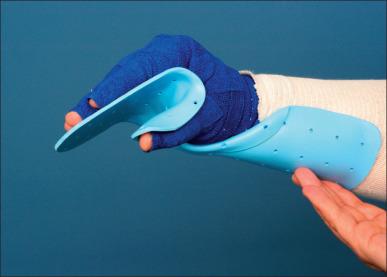
In the intermediate phase, positioning and splinting are used to prevent/correct deformities and protect surgically reconstructed sites. Splints may be fabricated dorsal, volar, or on the medial/lateral aspects. Contractures are a major complication of hand burns because they affect one's ability to perform ADLs. Joint contractures have also been found to negatively impact quality of life in burn survivors, especially with regard to physical function, role limitations, pain, and vitality. Dorsal hand burns are prone to contract into MCP hyperextension, IP flexion, and thumb adduction and should be splinted into MCP flexion, IP extension, and thumb palmar abduction. The most common post-burn upper extremity contractures are wrist flexion, index finger MCP hyperextension, index finger proximal IP flexion, and small finger MCP hyperextension/proximal IP flexion. The cupped palm deformity is functionally detrimental because it makes it impossible to smoothly reach around objects ( Fig. 47.12 ).
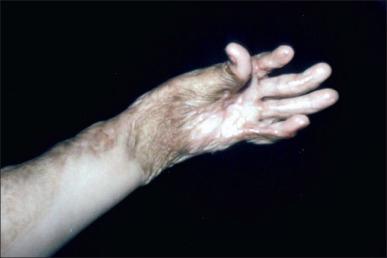
Burns to the volar surface of the forearm will predispose the patient to wrist flexion contracture, whereas burns to the dorsal surface will likely result in a wrist extension contracture. If the wrist ROM becomes limited in a specific direction, splinting the wrist in the opposite direction is indicated. The fifth digit is occasionally pulled into extreme abduction and hyperextension by scar contracture, muscle imbalance, or ulnar neuropathy. The thumb may become similarly displaced into adduction and retroposition. It is important to remember that the likelihood for MCP joint problems exists throughout scar maturation. Palmar hand burns are prone to MCP flexion and thumb opposition contractures and should be splinted into palmar extension and thumb radial abduction.
Static positioning with custom thermoplastic splints can be relatively efficient to implement in the clinical setting; however, a review of the literature indicates that there is no strong evidence for the use of static splinting in preventing scar contractures. More recently, a group of surgeons and therapists collaborated to look at serial splintage of the upper limb after burn injury and found that the preoperative use of splints may lead to lesser surgical interventions, and minor contractures may be completely corrected.
Two common faults are seen in custom splints that are designed to gain MCP flexion and to position the thumb in MCP flexion/radial abduction. If the distal transverse fold of the splint is not proximal to the MCPs of digits 2–5, the splint will impede rather than favor MCP flexion. If the thumb component of the splint applies volar pressure rather than medial pressure, the MCP will extend and the first metacarpal will become correspondingly more adducted. The first MCP joint should be maintained in slight flexion, and pressure from the splint should be applied just to the medial surface. Any degree of first metacarpal adduction contracture increases the likelihood that the proximal phalanx will be pushed into hyperextension and eventually into subluxation.
In the case of circumferential hand burns, a palmar extension splint is fabricated to prevent flexion contractures and a cupping deformity of the palm ( Fig. 47.13 ). The burn hand splint and an extension splint may be alternated. A “sandwich” splint may be fabricated that includes a burn hand splint with a dorsal shell over the IP joints to prevent flexion of the digits. All splints may be secured with elastic bandage or with Velcro strapping components ( Fig. 47.14 ). Individual gutter splints are used to prevent flexion contractures, to restrict boutonnière and mallet finger deformities, and to protect exposed extensor tendons until wound closure. Recently, a group of hand therapists has combined the use of digital gutter splints built into a compression garment to improve adherence to wear schedules in a pediatric population. C-bar splints are used to prevent adduction contracture of the first web space. Figure-of-eight splints are fit to correct or restrict swan neck deformities.
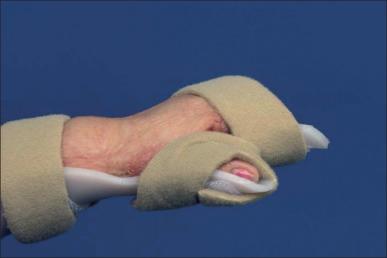
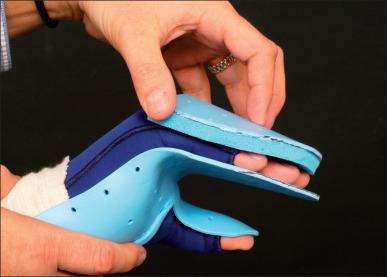
Dynamic splints are utilized to provide low-load prolonged stretch to counteract contractile forces and are recommended for the correction of scar contractures. Dynamic splinting of the hand will focus on MCP extension/flexion splints, IP flexion/extension splints, and thumb abduction and may include prefabricated or spring-loaded splints ( Fig. 47.15 ). Patients may require dynamic splinting to assist muscles weakened by peripheral neuropathy. The therapist monitors dynamic splinting closely and makes frequent adjustments in order to provide effective tissue mobilization. Additionally, the fit of dynamic splints is checked frequently to ensure that the anatomical structures remain properly aligned.

When anterior burns extend from the abdomen to the thigh, hip flexion is the position of comfort. If the hip is fixed in any degree of flexion, posture will be modified. Bilateral symmetric contractures impose increased lumbar lordosis, knee flexion, or both. Asymmetric contracture will cause pelvic obliquity and scoliosis. In adults and older children, thighs are more likely to be held in adduction than in abduction, whereas in preambulatory infants the secondary component of the contracture is abduction. Thus, for the hips, the preventive position is full extension, 0-degrees rotation, and symmetric abduction of 15–20 degrees. If elevation of the upper body is needed for edema reduction, then the entire frame of the bed is elevated with the use of wooden shock blocks placed at the head of the bed or the bed is placed in reverse Trendelenburg with support of a padded footboard. Soft mattresses should be avoided because they may promote hip flexion. Hip positioning is accomplished with the use of abduction pillows and other strapping mechanisms that eliminate hip rotation. If the patient wears bilateral foot splints, then connector bars may be utilized on the splints to bring about the desired bilateral hip positioning stated earlier. Hip flexion contractures may be serially corrected with an anterior hip spica or with a three-point hip extension splint ( Fig. 47.16 ). Subtle hip flexion contractures can be easily overlooked when the patient stands, there being only a slight increase in lumbar lordosis or forward or lateral shift of the trunk. If established hip flexion contractures are not surgically corrected, body posture is likely to be permanently altered with scoliosis or exaggerated lordosis.
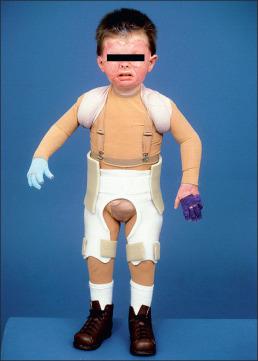
Burn injury to the anterior or posterior surface of the lower extremity that crosses over the knee joint may result in knee flexion. Deep anterior burns may expose the joint, occasionally destroying the patellar tendon. Deep posterior burns result in bridging scar formation. The appropriate position for the knee is full extension to be maintained by splint or, in severe cases, skeletal traction until there is efficient quadriceps function and the patient is ambulatory. Thereafter, night splints must be used until scar contracture is no longer a threat. Knee splints may include a posterior custom-made thermoplastic knee conformer or a soft knee immobilizer.
Persisting bilateral knee flexion contractures will impose hip flexion. Persisting unilateral contractures may impose pelvic obliquity and scoliosis. As with the hip, posture alteration may be so subtle as to be overlooked. Correction of even a slight contracture should be a surgical priority, as should elimination of a soft bridging scar band that does not prevent complete willful knee extension but causes the patient habitually to hold the knee in slight flexion.
Ankle equinus is the most frequently occurring deformity involving the foot. Initially, it is related more to gravity and failure to support the foot at neutral at the talotibial joint than to the early effect of the burn. Loss of deep and superficial peroneal nerve function will compound the problem by encouraging the foot to drift into inversion as well as equinus because of loss of dorsiflexion and eversion motors. In the end, the total deformity for the unsupported foot may be ankle equinus, hindfoot inversion, and forefoot varus and equinus. Ankle equinus quickly becomes a resistant deformity so that, within a few days or even hours, the foot can no longer be positioned at 90 degrees of dorsiflexion in the neutral ankle position. Eventually the contractures of scar, muscle, and capsular structures combine to fix the deformity.
Equinus deformity and the attending inversion and forefoot varus can be prevented by accurate and unyielding support of the foot in neutral alignment or slight dorsiflexion. If the patient must be nursed prone, the feet must be allowed to fall free from the mattress. Static splinting, if not performed correctly by an experienced therapist, is often unsuccessful because of the patient's desire and tendency to plantarflex strongly, displacing the splint and leading to ulcers of the heel, malleoli, toes, and where the splint edges touch the skin. A stable footboard may be effective if the feet are kept securely and totally against it. For large burns and particularly for circumferential burns of the lower extremities, skeletal suspension incorporating calcaneal traction will support the foot at neutral if the traction pin is placed in the calcaneus well behind the axis of ankle motion. A balanced traction system demands that the knees be supported in flexion with tibial pins at the level of the tibial tubercle. Calcaneal pins will not prevent forefoot equinus. If traction must be employed for several weeks, proximal-pull dorsal pins in the first or first and second metatarsals may be required for support of the forefoot. Transmetatarsal pins are useful as well when calcaneal traction alone is not sufficient to correct equinus.
Minor established equinus deformity can be corrected with a standing and walking program. At the outset, graduated heel lifts may be used to accommodate to the deformity. If the patient must be bed-confined, skeletal traction through the calcaneus may be the quickest and most efficient way to correct the deformity. Traction is effective even if scar contracture contributes to the deformity. Serial corrective casts or posterior splints alone are useful mainly for minor contractures. For the treatment of circumferential foot/ankle burns, anterior foot splints are also fabricated and their application is alternated with the posterior foot splints in preventing plantar or dorsal foot contractures. The Multi Podus System foot splints may be utilized for the positioning of the burned foot/ankle because they relieve heel pressure and prevent pressure ulcers ( Fig. 47.17 ). For fixed, unyielding deformity, scar release combined with tendo-Achillis lengthening with or without posterior capsulotomy is a standard surgical procedure that yields inconsistent results. The correction achieved is often just to neutral or to slight dorsiflexion. The Ilizarov technique has been used with generally satisfactory immediate results in severe cases. No matter how correction is achieved, if there are no dorsiflexion motors and if the range of ankle motion is only a few degrees, ankle fusion may in the end yield the best functional result.
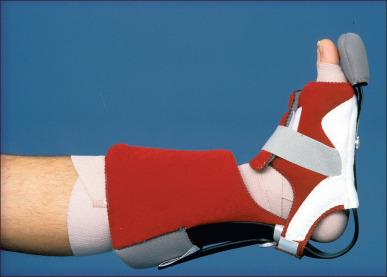
The most common intrinsic deformity of the foot is extreme extension of the toes due to dorsal scar contracture. This deformity is insidious in onset and is difficult to prevent because there is no type of nonskeletal splinting that will hold the toes flexed. In its extreme, the deformity includes dorsal metatarsophalangeal (MTP) subluxation, which may involve one or all toes depending on the location of the scar. The metatarsal heads become prominent on the plantar surface and walking may be painful. Correction of the deformity requires dorsal surgical release of the contracture, manual correction of the deformity, and, in severe cases, intrinsic or extrinsic pinning of the digit or digits in an overcorrected position (i.e., MTP and interphalangeal flexion). The deformity will commonly if not inevitably recur to some degree unless the patient, after the operation, is able to achieve active MTP flexion in all digits.
Dorsal scar contractures extending from leg to foot to toes may pull the foot into marked inversion if the scar is medial or into eversion if the scar is lateral. The fifth and first toes may be separately displaced by the same scar bands. These contractures must always be surgically corrected. Their persistence will lead to bone deformity in a growing child and will permanently adversely affect foot and ankle function. Even slight inversion, whether imposed by scar contracture or motor weakness, will increase pressure on the lateral border of the foot, leading to callus formation and a painful, inefficient gait. Occasionally the base of the fifth metatarsal is so offensive as to require partial surgical osteotomy.
When there is both anterior and posterior scar contracture, the talus will remain aligned with the calcaneus in a relatively plantar flexed position as the midfoot and forefoot are pulled into dorsiflexion. The result is so-called rocker bottom foot with the head of the talus being the principal weight-bearing feature. This deformity once established defies correction by usual surgical means because of the shortage of soft tissue and because vessels and nerves cannot be stretched to accommodate the corrected position. The Ilizarov technique may offer a partial solution to the problem. Removal of the head of the talus may give a reasonable weight-bearing surface. With chronic painful ulceration, amputation is the best treatment.
Multiple articles have been written about surgical interventions for burns to the feet in both adults and children. The approach of the orthotist in treating the injured foot depends on the extent of the burn injury. Contracture deformities of the feet after burn injuries present a complex problem for all members of the burn rehabilitation team. The options for management include orthopedic shoes with and without modifications, orthotic inserts, ankle–foot orthoses (AFOs), and heel lifts. Orthopedic shoes, which are the fundamental component of lower extremity orthotics, may be utilized with some modifications in correcting deformities of the burned foot. Modifications of these shoes may include arch pads, molded foot thermoplastics, tongue pads, and metatarsal bars. The ideal shoes should distribute all forces to the foot appropriately, reduce pressure on sensitive or deformed structures, and encourage total surface weight-bearing along the plantar aspect of the foot. Inserts for plantar foot support, such as the University of California Biomechanical Laboratory (UCBL)-type, may be utilized as indicated.
During the preambulation stage, the patient may be fitted with those orthotic devices mentioned earlier; if properly utilized, they can position the ankle joint in a balanced position, assist in preventing or correcting plantar/dorsal contractures, and correct inversion/eversion of the foot.
Leg length discrepancies are seen frequently in the cases of severe lower-extremity burn injuries and should be addressed with a shoe lift. The ankle–foot complex is difficult to address, especially in the case of a severe thermal injury. In most cases, the resultant deformity is the equinovarus foot. Both conventional and thermoplastic systems may be designed to treat the equinovarus or equinovalgus foot. Such systems may include a metal AFO, polypropylene plastic posterior AFO (solid ankle or with an articulation), an AFO with stirrup attachment, or an AFO with stirrups and patellar tendon support. A dorsiflexion spring assist may be incorporated in the AFO to aid weak ankle motion. Different straps, such as a valgus correction strap, may be attached to the AFO for the correction of specific problems. Interface materials, such as silicone, Plastizote, and Aliplast, can be incorporated into an AFO to provide protection of the soft tissues, provide for total surface weight-bearing, and accommodate any anatomical anomalies that may be present ( Fig. 47.18 ). In the event that a return of ROM is anticipated, an AFO could be fabricated that can be modified as the patient progresses. As described, the ankle joint is incorporated into the AFO; however, the device is left solid and articulated at a later date.
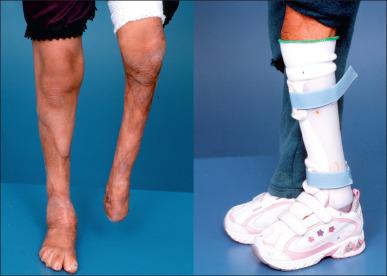
During more complicated cases, and depending on the anatomy and function of the lower extremities, a knee–ankle–foot orthosis, hip–knee–ankle–foot orthosis or a trunk–knee–ankle–foot orthosis may also be designed for the best functional outcome.
Multiple authors have identified serial casting as a treatment option for burn scar contracture management. Casting has been used in patients with burns for postoperative immobilization to promote graft adherence and to minimize scar contracture during the remodeling phase of healing. Circumferential casting after skin grafting to the lower extremity has been an effective means of providing protection to the grafted area. Serial casting has been used successfully on outpatients with burns when active ROM is limited due to scar tissue formation. Dewey, Richard, and Parry described serial casting as an alternative to the use of orthotic devices for contracture management in the presence of burn scars.
The literature has several examples of casting being used as an anticontracture device for the hand, wrist, elbow, axilla, knee, and ankle. In a retrospective study published in 2000, Richard, Miller, Staley et al. compared patients treated with a multimodal approach of scar massage, therapeutic exercises, and pressure therapy to those treated with a progressive approach that included static or dynamic splints and serial casting; the authors found significantly fewer days were required to correct the burn scar contractures in the progressive treatment group.
Casting works based on the biomechanical principle of stress relaxation in much the same way as a static splint design does. Similar to static splinting, serial casting is a rehabilitation approach used to increase elongation of scar tissue. The application of a series of casts provides a low-force, long-duration stress that can cause a permanent, plastic deformation of connective tissue. The goal of serial casting is gradual realignment of the collagen in a parallel and lengthened state by constant circumferential pressure. Prolonged, gentle, sustained stretch provided by the cast aids in tissue elongation for the correction of contractures ( Fig. 47.19 ). Burn scar under constant traction shows collagen formation in parallel alignment along the forces of stress. Low-intensity force with prolonged duration of stretching can be applied to connective tissue whether it is scarred, contracted, or surgically shortened.
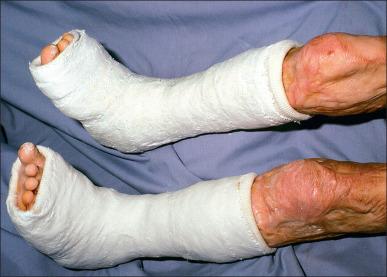
A review of the literature indicates that serial casting is typically used when the patient is noncompliant, does not tolerate splints, there is persistent ROM limitation, or a skin graft site requires protection or immobilization. Serial casting can be a relatively simple, fast, and painless intervention and provides an alternative to complex splinting when patient compliance is an issue (e.g., in pediatric patients or patients with decreased arousal). Bennett, Helm, Purdue, and Hunt casted 35 patients with scar contractures at an average of 161 days after burn injury and found that all had significant improvements in ROM, which raises the question of why serial casting is so often considered a last resort.
Additionally, clinicians may be hesitant to apply a cast because of open wounds, despite the fact that serial casting has been advocated for protection of involved sites after skin grafting. Ricks and Meagher evaluated cast application immediately after skin grafting in 36 patients with lower-extremity burns. They found that the casted group had significantly fewer days from skin grafting to wound closure, a higher rate of graft adherence, and needed fewer surgical treatments for deficits in ROM. The use of serial casts is often advocated as a last-resort treatment when a patient does not respond to traditional therapy and is often used primarily in the long-term phase of recovery.
The process of cast fabrication has been described for use in both the adult and pediatric patient populations. A precasting assessment should include goniometric measurements, end-feel assessment of the involved joints to determine the structures involved, duration of limitation, skin or wound status, neurovascular status, functional needs, and cognition of all involved parties. The patient is educated on the position in which the cast will be applied, the expected duration of casting, and any restricted activities. Ridgway described the serial casting technique and sequence: (1) skin hygiene, (2) scar massage with moisturizer, (3) ROM exercises and assessment, (4) wound dressings, (5) application of a silicone insert, 6) extremity in figure-of-eight wrap or tubular bandage, (7) padding over bony prominences, and (8) one therapist to position and one therapist to fabricate cast. Clinicians need to provide adequate pressure relief over bony prominences, however, to prevent skin breakdown. The clinician should only allow a minimal time lapse between cast removal and cast reapplication. Serial casting may be supplemented with static splinting of the adjacent joints.
Patients may require premedication and may also benefit from soft-tissue preconditioning (heating) for stretch prior to cast application. Precautions should be taken to ensure proper and evenly applied padding, including extra layers at the proximal and distal ends of the cast. The casting material should be rolled out and handled with an open hand as much as possible. Aggressive molding or overtight applications are to be avoided and can lead to compression neuropathies or vascular compromise. When cast materials harden, an exothermic reaction occurs causing the temperature within and beneath the cast material to rise, which leads to elevated temperatures and the risk of burn injuries. The greatest risk of thermal injury occurs when a thick cast using warm dip water is allowed to mature while resting on a pillow. Excessively thick casts and a dip-water temperature of higher than 24°C should be avoided. Placing the limb on a pillow during the curing process of the cast puts the limb at risk for further injury and should be avoided.
A variety of materials are available for the fabrication of casts. The most widely known would probably be plaster-of-Paris. Plaster is fast setting when reacting with lukewarm water. Plaster casts are inexpensive, strong, and easy to fabricate. However, they require longer drying times (24–48 hours), are prone to indentations and skin irritations, and are heavy. Other disadvantages of this technique include decreased water resistance and breakage if not constructed strongly enough. Plaster casts may be removed with a cast saw or moistened and removed with scissors.
Fiberglass casting material is an alternative to plaster-of-Paris. Fiberglass casting tape is fast setting when reacting with cool water. Fiberglass materials require a shorter drying time (15–30 minutes), are lightweight and durable, and offer resistance to dirt and water. Fiberglass casting methods are costlier than plaster. Because of fiberglass's abrasive properties, therapists must wear gloves when handling the materials during cast fabrication and removal. The patient's skin and clothing should be protected from contact with the fiberglass casting tape, as well as with fiberglass fibers during cast removal. Fiberglass casts require a cast saw for removal.
Recently, nonlatex polyester materials such as Delta-Cast have been utilized as alternatives to plaster and fiberglass. These materials, which resemble fiberglass, are very lightweight, flexible, and, because of their elastic properties, conform very well. These casts may be cut in a bivalve fashion so that they can be removed and reapplied after wound care, hygiene, and exercise.
After cast fabrication is complete, the clinician should check the firmness of the cast, neurovascular status of the extremity, sharpness of cast edges, and any signs of the cast rubbing adjacent structures. When casting is completed, the patient should feel a gentle but not painful stretch. The first cast should be removed at approximately 24 hours; thereafter, depending on the patient's tolerance, it could be applied for up to 1 week at a time. In the literature, the reported frequency of cast change ranges from daily to every 10 days. In cases of casting over open wounds, the cast should be removed every 1–2 days to avoid complications in wound healing. The use of insert material for scar management under casts has been documented and found to be useful. Serial casting is terminated when either normal ROM has been restored or no further functional gains are achieved.
According to a consensus summit of burn care professionals, the traditional thought processes regarding the use of serial casts with the burn patient need to be re-evaluated, casting regimens need to be standardized, and studies are needed to evaluate serial casting at various stages of burn recovery and the overall effectiveness of the modality for contracture management.
A prosthesis is a device used to replicate the function and appearance of a missing limb. Amputations among the burn patient population most often occur as a result of electrical insults but can also result from more severe thermal injuries as well. They have a significant physical and psychological consequence, which impacts quality of life. Prosthetics are designed, fabricated, and fit by a certified prosthetist. Each device is individualized based on the needs of the patient. But, in general, the prosthesis should be comfortable to wear, easy to don/doff, lightweight, of durable construction, and be cosmetically appealing. The prosthetist and rehabilitation professional will consider the following when designing the prosthesis and its components: level of amputation, shape and contour of the residual limb, functional expectations, cognitive abilities, vocational requirements, hobbies/leisure pursuits, and financial resources. Standard prosthetic texts are useful in providing broad basic information and explanations of the many components available and their use.
Patients who have sustained severe burns and subsequent amputations have complex, long-term impairments and face considerable functional deficits.
Severely burned patients tend to have sensorimotor limitations in the intact extremities that may affect their ability to utilize a prosthesis. Their limitations and strengths are important considerations when planning treatment. These patients may exhibit muscle weakness not usually seen at the same amputation levels in the nonburn patient. Areas of weakness should be noted and compensation, such as increasing joint stability through alignment or componentry, should be provided. Burned individuals may use their remaining functioning extremities differently than patients without total body involvement. Prosthetic rehabilitation should enhance adaptations and necessary compensatory methods. The challenge to the prosthetist is to design a device that is maximally useful to a person who may have multiple limitations. To be useful, a device must be as easy to use as possible. Simplicity often determines whether the device is successful or discarded.
Prostheses may be preparatory or definitive. Preparatory devices are those fitted while the residual limb is still maturing. A preparatory prosthesis is provided when reduction of stump volume is anticipated or when fitting over a bulky dressing is necessary. These devices are usually simple, passive devices that allow for early motion skills and weight-bearing through the affected limb. Some patients will continue to use their preparatory prosthesis for extended periods of time while other areas of the body are treated. Prior to definitive fitting, body weight, residual limb volume, and wear and use patterns should be stable in order to optimize the long-term result with the definitive prosthesis. The definitive prosthesis is fitted when the residual limb is fully mature. The use of a preparatory prosthesis is not mandatory, but the use of one will improve the fit and control of the definitive prosthesis and may, secondarily, reduce the amount of time needed for rehabilitation post-burn injury.
Prosthetic preparation in burn rehabilitation begins in the postsurgical phase. Early prosthetic treatment of an amputee includes splinting for the prevention of contracture. An upper extremity splint may extend past the distal end of the residual limb to match the length of the whole limb, thus assisting a patient in retaining the concept of length. Initially, therapists must address: promotion of wound healing; pain management, residual limb shaping, prevention of contractures, skin desensitization techniques (tapping, massage, scar mobilization, pressure application), edema control, and coping mechanisms for adjustment and grief. With early socket fitting, some skin problems will be encountered, but these are not usually of major significance. Silicone gel or urethane socket inserts have been used successfully for pressure relief to burn-scarred skin. As wound healing progresses, prosthetic training will begin to focus on care of the prosthetic device, don/doff methods, skin inspection routines, weight-bearing with the device, and progressive functional skills.
Just as upper extremities are different from lower extremities, so, too are upper- and lower-extremity prostheses. The minimum requirements for successful use of an upper-extremity prosthesis are trunk control to support an upright posture, sufficient upper body strength to selectively activate the control devices, and static and dynamic balance skills. The patient will need to be trained on specific body movements to develop control of the upper-extremity prosthesis. Glenohumeral flexion provides excellent power and reach for functional routines. It can be used to flex the elbow, activate the terminal device, and for activities away from the midline of the body. Scapular protraction is also trained for activation of the terminal device and facilitation of fine motor tasks at midline or close to the body. The other motions of glenohumeral depression/elevation, extension, and abduction are most frequently used to lock or unlock an elbow joint.
Different types of upper-extremity prostheses are available along a continuum from mostly passive or cosmetic to primarily functional. Most devices fall somewhere in the middle range between cosmesis and function. Cosmetic prostheses are difficult to keep clean, expensive, and ultimately sacrifice function for appearance. Functional prostheses fall into two categories. They can be designed to be body-powered (using cables) or externally powered (myoelectric or switch control). Body-powered prostheses are moderate in cost and weight, more durable, and offer higher sensory feedback. However, they require more gross limb movement and can be less cosmetically appealing. Externally powered prosthetic devices allow for more proximal function, greater strength for grasp/prehension, and improved cosmesis. Additionally, they may be heavy and expensive, offer less sensory feedback, and require more regular maintenance. Regardless of the type of prosthesis planned for, fitting of an upper-extremity body-powered prosthesis within 7–30 days correlates with higher acceptance and success rates. Body-powered prostheses are most commonly used in burn rehabilitation, and Table 47.1 describes the components of upper-extremity prosthetic devices.
| Upper Extremity | Functions | Lower Extremity |
|---|---|---|
| Socket | Interface between prosthesis and residual limb | Socket |
| Selective loading/pressure relief | ||
| Suspension | Holds prosthesis to residual limb | Suspension |
| Force transmission for function | ||
| Control system: Usually movement of the shoulder or chest | Links movement of a body part to the prosthesis | Control system: Usually movement of the hip or knee |
| Interposed elbow joint | Performance of hand to midline | Interposed knee joint |
| Provides support during stance phase, smooth swing phase, and motion for sitting and kneeling | ||
| Interposed wrist joint | Attaches socket to terminal device; orients terminal device in space | Shank (pylon) |
| Terminal device | Restores cosmetic appearance | Prosthetic foot |
| Replicates anatomic joints | ||
| Replaces hand/ankle function | ||
| Stable, weight-bearing surface | ||
| Shock absorption |
The rehabilitation upper-extremity prosthetic goals should include stability of the shoulder girdle to allow prehension, overall ease of movement of the entire limb, energy-efficient use of the device, and the appearance of a normal upper extremity. Table 47.2 describes upper-extremity amputations by level and identifies the appropriate prosthetic device to address the patient's functional needs.
| Types of Amputations | Prosthetic Needs | |
|---|---|---|
| Upper extremity | Transphalangeal | Passive for cosmesis |
| Transmetacarpal | Oppositional devices | |
| Transcarpal | Body-powered hand or hook | |
| Wrist disarticulation Transradial |
Forearm socket, wrist component, and terminal device | |
| Elbow disarticulation Transhumeral |
Proximal arm socket, elbow hinge (passive, active, or externally powered), forearm lever arm, wrist component, and terminal device | |
| Shoulder disarticulation | Harness system and transhumeral components | |
| Interscapulothoracic disarticulation | Harness system, shoulder socket and transhumeral components | |
| Lower extremity | Transphalangeal Toe disarticulation Ray amputation Transmetatarsal Transtarsal |
Toe-filler Foot plate Partial foot to tibial height prosthesis |
| Syme | Socket to knee, low-profile foot | |
| Transtibial Knee disarticulation |
Socket with foot and ankle | |
| Transfemoral | Socket, knee joint, and ankle/foot complex | |
| Hip disarticulation Hemipelvectomy |
Socket is total contact shell, hip/knee joints, and ankle/foot complex | |
The rehabilitation program for successful use of lower-extremity prosthetics begins with donning/doffing of the device, transfer skills, activities to build wearing tolerance, practice to reinforce balance reactions, and preambulation skills. Preparatory weight-bearing treatment for use of a lower-extremity prosthesis usually begins on a tilt table, progressing to standing and then ambulation in the parallel bars. The rehabilitation goals should address stability, ease of movement, energy efficiency, and the appearance of natural gait. Table 47.1 outlines the common components of lower-extremity prostheses and their functions.
Lower-limb prosthetics require the following minimum requirements for successful use: upright trunk control, sufficient upper body strength, adequate lower-body stability and control, static and dynamic balance skills, and good postural alignment. Lower-extremity prosthetic fitting begins when the patient's wounds are well-healed and will tolerate pressure and weight-bearing. Lower-limb devices may be either preparatory or definitive. Table 47.2 details types of lower-extremity amputations by level and identifies the appropriate prosthetic and components.
Two common sequelae of traumatic amputations are phantom sensation and phantom pain. Phantom sensation is the perceived sense that the amputated limb is still present. It is not typically characterized as painful by the patient. The patient may report feeling that the amputated limb has shrunk (telescoping). In contrast, phantom pain is the sensation of pain originating in the amputated part. Upon assessment, the pain may or may not be dermatomal in presentation. The patient may report constant burning, stinging, cramping, or a feeling of awkward positioning. Phantom pain is most intense acutely, gradually becomes intermittent, is worse at night, and is often exacerbated by stress/anxiety. From a therapy standpoint, phantom sensation may be managed by desensitization techniques, whereas phantom pain may be responsive to transcutaneous electrical nerve stimulation.
The overall process of prosthetic evaluation and fitting is described in Fig. 47.20 . Satisfactory use of a prosthetic device in burn rehabilitation requires continuous dialogues among the patient, therapist, prosthetist, and surgeon. Return clinic visits should include consistent prosthetic re-evaluation. However, ultimately, the use of a prosthetic device depends largely on patient motivation. Most prostheses can be expected to last at least 3–5 years with standard daily use. Children will need more frequent modifications or adjustments as they grow and develop. In general, the simplest system that provides the most functional–cosmetic level is accepted by the amputee as the best choice.
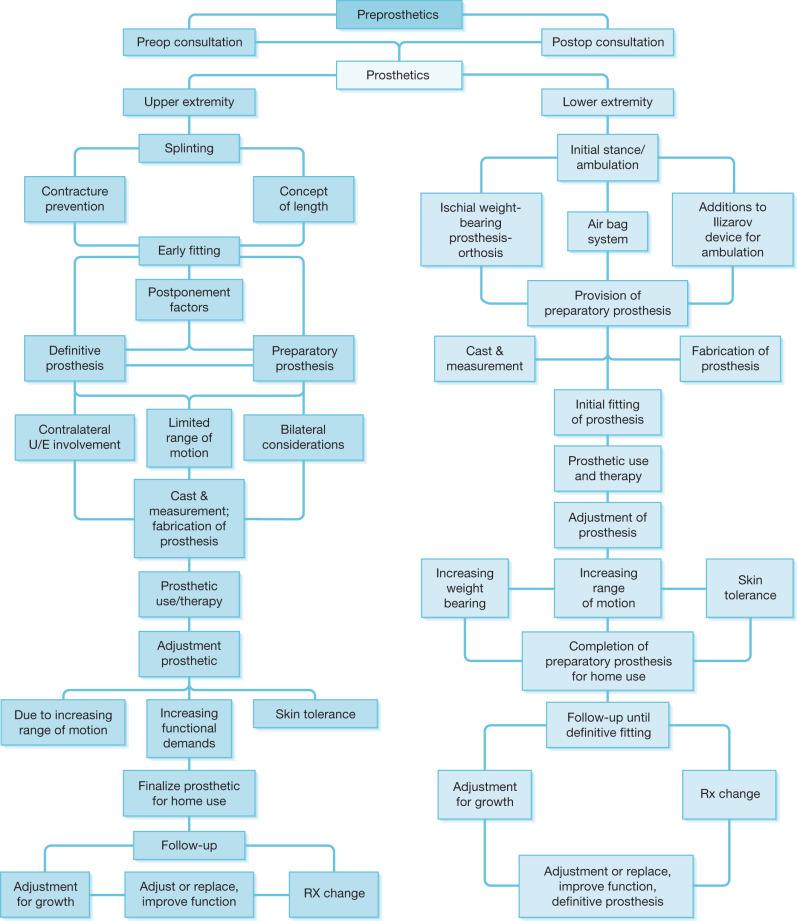
The burn wound, like any other wound, heals by the formation of scar at the injured site to replace the destroyed tissues. Scar is defined as the fibrous tissue replacing normal tissues destroyed by injury or disease. In the case of a burn injury, the scar, if not managed appropriately, has the potential of becoming thick and raised, resulting in scar hypertrophy. Hypertrophic scars are not cosmetically appealing, and, if they cross any joints, they may restrict movement and function. Pressure therapy for scar management is a very old and established component of a recovering burn patient's continuing rehabilitation program. Extensive historical notes on the earliest references to scarring are provided by Linares and colleagues, who attribute the first full medical description of scars to Petz in 1790. They also state that the first medical reference to the use of pressure for treatment was written by Johnson in 1678 referring to the work of Ambroise Paré in the sixteenth century. Other historical events noted by Linares et al. are the first known accounts of the use of pressure for treatment of children in 1859, use of elastic bandages in 1860, adhesive plaster for pressure in 1881, and use of traction to treat scars in 1902. Linares's review includes descriptions of Nason's work in 1942, in which he noted that ischemia produced by pressure arrests the overproduction of scar tissue, “where the imprint of the elastic of an undergarment or a belt may be seen—no keloid is present.” Another historical review by Ward reveals that Blair in 1924 reported the positive influence of pressure on healing wounds. Nason's application of the “constant pressure” principle included developing a type of neck splint made of a piece of dental impression compound or a piece of heavy felt strapped tightly over the scar for 6–8 weeks and possibly longer. Later, various splints were developed utilizing pressure and immobilization. In the 1960s, Silverstein and Larson observed the influence of pressure on fresh scars. Their observations led to the manufacture of custom pressure garments that revolutionized scar management in the 1970s and continue to be the most preferred method of managing scars to date.
As the burn wound closes, or after skin grafting operations take place, scars begin to form. Generally, the deeper the burn injury is, the higher the risk for the development of hypertrophic scars. Also, the longer a wound remains open, the higher the chances for hypertrophic scar formation. As the wound begins the healing process, collagen fibers develop to bridge the wound surface, forming an immature (active) scar, which appears as a red, raised, and rigid mass. Abston reported that pressure therapy while the scars were active led to flatter, softer, and more devascularized scars. Burn scars may take up to 2 years or longer to mature. Factors contributing to the formation of hypertrophic scars may include wound infection, genetics, immunological factors, repeated harvesting of donor sites, altered ground substance, age, chronic inflammatory process, location of the injury, and tension. Scar hypertrophy may be evident at 8–12 weeks after wound closure.
A thorough burn scar assessment should be carefully conducted by the burn therapist because the burn scar has serious implications on the final functional and cosmetic outcome at the completion of the rehabilitative process. Over the years, several scar assessment scales and individual scar assessment tools have been developed to quantify burn scars to determine the efficacy of scar management interventions. These scar assessment scales and tools are either objective (provide a quantitative measurement of the various scar characteristics) or subjective (provide an overview of the quality of the scar as measured by an observer). The Vancouver Burn Scar Assessment developed by Sullivan and colleagues is a subjective way of rating the burn scar pigmentation, vascularity, pliability, and height, and it is widely used among clinicians. Despite the fact that the Vancouver Burn Scar Scale is a subjective scale, it continues to be the most frequently utilized burn scar assessment scale by researchers to date. Baryza and Nedelec have attempted to improve the Vancouver scale through the years, and they have somewhat succeeded in doing so. Other scar scale assessments include the Patient and Observer Scar Assessment Scale (POSAS) and the Manchester Scar Scale (MSS). The majority of scar scale assessments available are thought to be subjective in nature and are criticized for their lack of validity and reliability. Hambleton and colleagues studied the thickness of scars with ultrasonic scanning. This method, which is completely noninvasive, allows for a comparison of the thickness of dermal tissue in the traumatized area with that in normal skin at regular intervals following initial healing. Darvey et al. described a technique for the objective assessment of scars utilizing a video camera image on a computer and quantitatively analyzing the color of the scars using a custom-written computer program. Esposito used a modified tonometer to measure skin tone, which correlates to skin pliability and tension. Bartell and co-workers used the elastometer properties of normal versus injured skin. In his study, Bartell showed that scars, if left untreated, will show improvement over time. Hosoda utilized laser flowmetry to determine the perfusion of hypertrophic scars versus nonhypertrophic scars. Other studies suggest that laser Doppler flowmetry and monitoring of transcutaneous oxygen tension may in the future be ways of determining scar maturation.
Fearmonti et al. have compared several scar assessments and individual scar measurement devices and have highlighted their insufficiencies and limitations. A comprehensive, reliable, and valid burn scar assessment that is inclusive of all major scar characteristics relevant to burn rehabilitation has yet to be developed. Individual scar characteristic assessment devices may, in some instances, show some reliability and validity; however, they are cost-prohibitive and impractical to use in the clinic on a daily basis.
To date, hypertrophic scars remain very problematic and difficult to manage. Even though the mechanism of scar maturation is not yet well understood, clinically, the accepted protocol to treat hypertrophic scars includes the use of pressure therapy, which should be instituted early on in the maturation process of the burn scar. Means of pressure therapy include pressure garments, inserts, and conforming orthotics. Once the skin has healed enough to withstand shearing, massage and heat modalities may be utilized as an adjunct in scar management. The use of pressure in effectively depressing scars was well documented by Silverstein and Larson in the 1970s; their observations and studies sparked the near-universal use of pressure garments. When an active scar is compressed, it blanches, which indicates decreased blood flow in the area. Less blood leads to decreased oxygen in the tissues, which in turns leads to decreased collagen production, which brings a balance between collagen synthesis and collagen breakdown (lysis). When a balance in the production and breakdown of collagen is established, the resultant scar appears flatter. Kealey et al. conducted a prospective randomized study to compare the efficacy of pressure garment therapy in patients with burns. Patients were randomly assigned to receive either pressure garment therapy or no pressure garment therapy. Assessment of the maturity of scar included use of the Vancouver Burn Scar Assessment Scale. The results on 113 patients studied in the follow-up revealed no significant differences between groups when age, body surface area burned, length of hospital stay, or time to wound maturation were compared. In addition to this study, other studies have reported problems related to lack of adherence and discomfort, blistering, ulceration or scar breakdown, swelling of extremities, and skeletal and dental deformity due to excessive pressures, which often leads to cessation of treatment, significant side effects, and deformity.
On the other hand, studies have also reported benefits of pressure garments. The reader is referred to various recent excellent review articles on the efficacy or lack of efficacy of pressure garments in the management of hypertrophic burn scars. The reason for the absence of unequivocal evidence is that garments must be worn continuously for a least 23 hours a day, making compliance or adherence difficult. In addition, the optimal pressure that must be applied to the scar for treatment is not known. Thus the studies and debates continue, and, at least until more evidence is gathered, pressure therapy with the familiar elastic garments is still prescribed. Patients and families would no doubt feel relieved if the data eventually show that pressure does not make a significant difference in long-term outcomes. However, it should be noted that the studies thus far include neither the examination of burns over joints nor do they include burns of the hands, neck, and face. In addition, none of the studies to date addresses the use of pressure in the form of splints, another source of discomfort and tension for burned children and their families.
None of the known studies has yet broached the face with an attempt to determine the efficacy of pressure versus no pressure. Facial pressure garments in children may pose problems due to interference with growth. We recommend that these patients should be closely monitored for normal facial and dental development by physicians, including dental specialists. The elastic hood and underlying silicone face pad present special problems for patients, and some extreme challenges for the adults trying to assist a burned child or adolescent. The elastic mask and hood, covering head, face, and hair, effectively hides the identity of the person wearing it. It is perceived by children as sinister, associated with “bad men” or monsters, and most children who have worn this garment can relay stories of being ridiculed by strangers who did not know the purpose of the garment. Emotional expressiveness, usually apparent in facial movements, is hidden by the hood. More than one child has explained nonadherence with the prescribed wearing of the elastic mask with a statement similar to “I want my friends to see me laugh.” A study by Groce et al. compared the elastic mask and hood with silicone pad to the transparent silicone face mask and found no significant differences between the amount of pressure applied by each to the forehead, cheeks, and chin. Many children have expressed a preference for, and seem to wear more readily, the transparent mask. This study should make it easier for them to be granted their choice—an important event during a time when so much is happening to them outside of their control.
As long as the scars are active, they may be influenced by pressure therapy. However, not all burn scars require pressure. Patients with burn wounds that heal within 7–14 days do not need pressure therapy. Those patients whose wounds heal within 14–21 days are closely monitored for pressure therapy needs and may be generally advised to use pressure garments prophylactically. A wound that heals after 21 days will require the use of pressure garments. The correct amount of pressure in suppressing the hypertrophic scar has not yet been determined. Pressure of as little as 10 mm Hg may be effective in remodeling the scar tissue over time. Pressures over 40 mm Hg, however, may be destructive to tissues and cause paresthesias. Early use of pressure therapy may improve scar outcome and accelerate time to scar maturity. The use of conforming thermoplastics along with elastic bandages may also be utilized as means of early pressure therapy. Once the wounds are almost or completely closed, tubular elastic bandages such as Tubigrip may be utilized. These tubular bandages are offered in different sizes and accommodate all anatomical circumferences. Care should be taken in applying these tubular bandages so that the fragile skin or the freshly applied skin grafts do not shear or that the minimal dressing underneath is not disturbed. The burn therapist should be aware that these tubular bandages are materials made of a single elastic thread spiraling through the weave of the fabric, and disturbance of the continuous elastic by cutting holes into it will alter the pressure gradient provided by these materials. The tubular elastic bandages should be doubled over the skin surface area treated to provide adequate pressure. Early pressure application over the hand and digits can be accomplished through the use of thin, elastic, and self-adherent wraps such as Coban ( Fig. 47.21 ). This form of pressure is excellent for adult and pediatric patients for controlling edema, and it aids in the early scar management of hands when the shearing forces of a glove cannot be tolerated. Small children are excellent candidates for Coban gloves versus a garment glove because of compliance issues, comprehension of instructions in assisting with the application of a custom glove, and difficulties in obtaining accurate measurements for a custom glove. Coban may be applied over the burn dressings or directly onto the healed digits. The burn therapist needs to be aware that if Coban is wrapped too tightly, it may deform the interosseous structures of the healing hand. However, if Coban is wrapped too loosely it may encourage swelling of the hands when used in combination with arm elastic garments. Coban strips are pre-cut approximately twice the length of the digits to be wrapped. Each strip is wrapped in a spiral fashion beginning at the nail bed of each digit, overlapping half of the Coban width and ending in the adjacent web space. Each fingertip needs to be exposed so that blood circulation can be monitored at all times. The Coban is stretched from 0% to 25% of the entire elasticity of each strip. Once all web spaces are covered, the rest of the hand is wrapped with Coban, extending approximately 1 inch past the wrist joint. No skin areas should be visible once the Coban glove is completed. If small hand areas remain uncovered, a small piece of Coban is stretched over the area and adheres to the rest of the Coban. When the glove is completed, the therapist should very superficially lubricate the entire glove with lotion to eliminate the adherent effect of the Coban and allow for the functional use of the hand. Coban should be removed on a daily basis by the therapist or caregiver. Removal of Coban should be done carefully by cutting off or unwrapping each digit individually to avoid disturbing any wound healing.
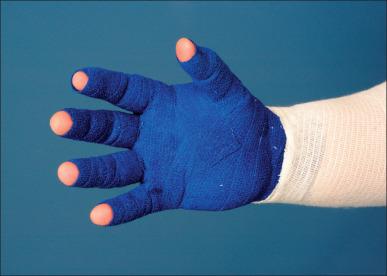
The use of prefabricated interim pressure garments is widely accepted and utilized in burn rehabilitation. These garments are available commercially from different companies, and they include pieces for the entire body. Interim garments, which are made of softer materials, introduce the burn patient to circumferential pressure and protect newly healed skin. Another reason for using these garments prior to ordering custom-made garments is to allow for the patient's weight to stabilize (post-acute hospitalization) and any remaining edema to subside. In some cases where obtaining custom-made garments on regular intervals (approximately 12 weeks) is not an option, the recommendation should be that interim garments should be the choice for long-term pressure therapy. Once the patient's weight has stabilized, edema has subsided, and the skin is able to withstand some shearing (approximately 3–4 weeks post-wound closure), measurements are taken for the fabrication of custom-made pressure garments ( Fig. 47.22 ). Today, several companies specialize in the fabrication of these garments. Clinically, custom therapeutic pressure for the prevention, control, and correction of scar hypertrophy averages 24–28 mm Hg, which is approximately equal and opposing to the capillary pressure (25 mm Hg). At this pressure level, many researchers believe that scars may be altered. In order for pressure therapy to be effective, pressure garments need to be worn at all times, day and night. They should only be removed for bathing and on occasion during exercises should they interfere with movements. Each order is duplicated so one set of garments can be worn while the other is being washed. Today, pressure garment companies offer multiple colors of materials and, for the pediatric population, cartoon characters may be sewed on the garments to make them cosmetically appealing and improve patient compliance. The burn therapist should choose a reputable company that provides excellent service and support for the patient and the therapist. The company's willingness and flexibility to manufacture nonstandard garments, availability of special options, cost, and turnaround time should be taken into consideration when selecting the burn center's pressure garment provider.
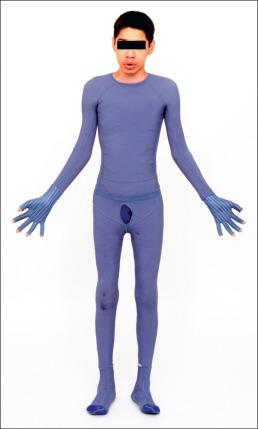
Inserts are widely utilized in burn rehabilitation as an adjunct to achieving effective pressure over certain anatomical locations where pressure garments do not provide adequate pressure. These locations include concave body areas such as the face, neck, antecubital fossae, sternum, palm of the hands, web spaces, upper back, and arches of the feet. These materials come commercially prefabricated or may be custom-made by the burn therapist. Inserts come in different forms, such as silicone/nonsilicone gels or gel sheets, elastomers, putties mixed with a silicone catalyst, skin care silastic pads, foam, and even in the form of hard thermoplastic materials contouring to different anatomical locations. The experienced burn therapist chooses the appropriate insert material best suited for the patient according to the stage of scar maturation and skin sensitivity. Generally, pressure therapy begins with a soft, thin, and elastic insert and progresses to a more rigid insert in depressing the more unyielding burn scar. Inserts need to be worn underneath pressure garments, starting with a few hours of application and progressing as tolerated toward a 23-hour application. The inserts should extend approximately 5 mm beyond the scar margins and should be applied for several hours the first day then increased by 2-hour increments every other day until the patient is able to wear it for up to 23 hours per day. They should be removed frequently for cleaning (warm water and soap), to avoid scar maceration and skin breakdown. Patients may be allergic to certain insert materials so the burn therapist may try different inserts until one is found to be best tolerated by the patient's skin. In cases of scar maceration, blisters, skin breakdown, contact dermatitis, a rash, or an allergic reaction, inserts should be removed immediately until healing occurs. Silicone, a polymer based on the element silicon, appears to be the trend in the treatment of hypertrophic scars. To date, the mechanism of how silicone affects the burn scar is not known. Clinically, silicone has been observed to depress the height of hypertrophic scars, prevent shrinking of fresh skin grafts (hard elastomer silicone pads vs. silicone gel pads), and increase the pliability of scars, thus allowing for increase in the ROM of affected joints. Silicone, being occlusive, may cause the collection of excessive moisture and cause skin maceration if not removed frequently for cleaning and drying. Its disadvantages are that it is very expensive and short-lived. The therapist should look for silicone gel pads with a nonshearing protective medium on the nonskin surface in order for the gel to last longer. Also, buying larger gel pads and cutting them to fit the patient's need may be a cost-effective method for working with today's shrinking clinic budgets.
Other insert materials include liquid silicone elastomer, which when mixed with a catalyst forms a solid but elastic insert ( Fig. 47.23 ). The experienced therapist is able to create custom inserts for difficult anatomical locations such as the face and web spaces using this technique. Prosthetic Foam is a liquid-based silicone elastomer which, when mixed with a catalyst, solidifies in the form of a very pliable foam insert that works best for the palm of the hands, where function needs to be preserved while pressure is applied. These foam inserts also work best for applying pressure to contour surfaces on the face (around the eyes, mouth, and nose) while protecting these sensitive areas from excess and rigid pressure. Elastomer putties such as Otoform K or Rolyan Ezemix form semi-rigid but still elastic inserts for different areas of the body where the scar can tolerate more pressure, such as in the web spaces to prevent syndactyly.
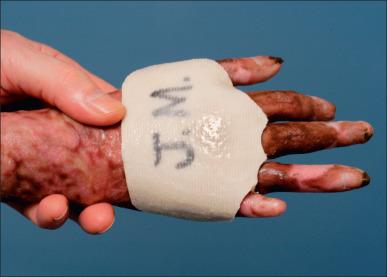
High-thermoplastic transparent masks were developed in 1968 by Padewski to be applied directly to the face to prevent, control, and reverse scar hypertrophy. These masks require the moulaging of the patient in creating a negative facial mold. A positive mold of the face is fabricated with the use of plaster. The patient's positive facial mold is then sculpted in an attempt to recreate the patient's nonburned face. A high thermoplastic material such as Uvex or W-Clear is then pulled over the positive mold to create the transparent face orthosis ( Fig. 47.24A ). Holes for the eyes, nose, and mouth are cut. The transparent face orthosis is worn with various harness systems designed to secure it to the face to address facial scar management. The use of three-dimensional scanners can replace the traditional methods of face orthosis fabrication. Using a scanner greatly reduces patient anxiety by achieving the same accuracy as moulaging in a fraction of the time without physically touching the patient's face. The scan is sculpted on a computer and a positive tool is manufactured out of foam off-site. The positive tool is then sent to the facility for face orthosis fabrication. In the past, scanners were so large that facilities had to dedicate an entire room to their use; today, scanners are small enough to fit in a portable case and are run by laptops. These newer portable scanners give a therapist the freedom to scan patients in any setting in the hospital including intraoperatively. In cases of significant scar hypertrophy on the face, the positive mold is sculpted sequentially over a period of time to avoid excessive pressure over facial scar that could lead to skin breakdown. A silicone elastomer face mask may be created utilizing the existing positive facial mold and is worn under facial pressure garments ( Fig. 47.24B ). The use of the clear and silastic masks is preferred over the use of just a facial garment because these masks provide conforming pressure around facial openings (eyes, nose, and mouth). Frequently, the burn therapist manufactures the clear orthosis to be worn during the day and the silastic mask along with the facial garment to be worn at night.
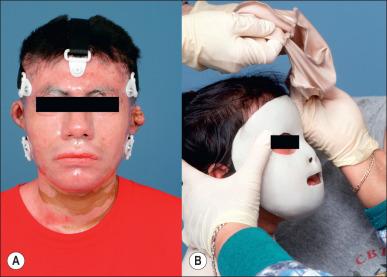
Become a Clinical Tree membership for Full access and enjoy Unlimited articles
If you are a member. Log in here